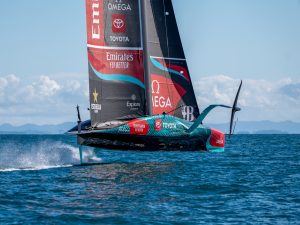
Amazing? Sure. The professionalism of the teams, the astounding level of thought, effort and yes, the money spent, that was put into the boats and everything surrounding them, from the branding to the crew equipment to the support craft, to the base camps were truly impressive. The modern era, post-12 Metre, has seen the professionalism curve go continuously upward. But this edition, with its add-ons like a Women’s and Junior America’s Cup, sailed in one-design foiling monohulls, was truly a big step forward. It was a quantum leap toward that goal of emulating or even surpassing the levels of Formula 1 auto racing in terms of technology, style and frankly, largesse.
You know what else the 37th America’s Cup was? Amazingly boring. How ironic is it that to get even a remotely exciting race, where the outcome was not decided at the first cross, the wind speed had to be perilously close to the bottom end of the rules range, where falling off of the foils would be a literal game-changer. Remember explaining to your friends why light air racing in the IACC Class boats was actual nail-biting excitement? It was an easier sell when it was windy because the boats might break or even sink! And the power of the boats and skills of the crews in heavy air was clear to even a layperson.
But these fantastic machines, the AC 70s, are not the problem per se. The main culprit is the rules. One of the interesting things about sailing is the wide diversity in the ways in which we compete. It reminds me of being a kid and saying, “Over the garage is a home run, but off the roof is only a double.” Considering how much tradition there is, it is surprising how much our sport tweaks the rules, formats and craft, usually in an attempt to make it more fun or challenging. Back in 1989, my partner Scott MacLeod and I set out to make match race sailing a spectator sport. This was our business, so the changes had to work. The sailors, just at the dawn of being fully professional in this type of sailing, understood, pushed, and mostly accepted the changes we made. Almost everything we changed or adopted, from delayed offsetting penalties and starboard roundings to short courses in shifty venues, was designed to help the trailing boat. We wanted, no, we needed, passing. It helped that symmetrical spinnakers were used, unlike the current AC 70, where the lead boat throws off bad air both upwind and down.
I could go on and on, but the short answer is, if the Kiwis really want to make it a sport where the host venue actually wants to renew, they have to throw away practically everything about how they are running the races. Unfortunately, exciting racing is not in their interest. They are supremely good at what they do…collaborating, designing, building, innovating and performing on that track. Excitement is not what they are looking for. Winning is.
Publisher
Benjamin V. Cesare
ben@windcheckmagazine.com





